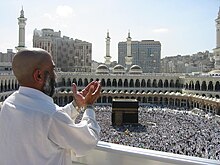
Muslims are people who adhere to Islam, a monotheistic religion belonging to the Abrahamic tradition. They consider the Quran, the foundational religious text of Islam, to be the verbatim word of the God of Abraham as it was revealed to Muhammad, the main Islamic prophet. Alongside the Quran, Muslims also believe in previous revelations, such as the Tawrat, the Zabur (Psalms), and the Injeel (Gospel). These earlier revelations are also associated with Judaism and Christianity, which are regarded by Muslims as earlier versions of Islam. The majority of Muslims also follow the teachings and practices attributed to Muhammad (sunnah) as recorded in traditional accounts (hadith).

The terms Muslim world and Islamic world commonly refer to the Islamic community, which is also known as the Ummah. This consists of all those who adhere to the religious beliefs, politics, and laws of Islam or to societies in which Islam is practiced. In a modern geopolitical sense, these terms refer to countries in which Islam is widespread, although there are no agreed criteria for inclusion. The term Muslim-majority countries is an alternative often used for the latter sense.
Religion in Africa is multifaceted and has been a major influence on art, culture and philosophy. Today, the continent's various populations and individuals are mostly adherents of Christianity, Islam, and to a lesser extent several traditional African religions. In Christian or Islamic communities, religious beliefs are also sometimes characterized with syncretism with the beliefs and practices of traditional religions.
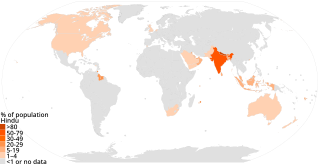
Hinduism has approximately 1.2 billion adherents worldwide. Hinduism is the third largest religion in the world behind Christianity (31.5%) and Islam (23.3%).

The Barmakids, also spelled Barmecides, were an influential Iranian family from Balkh, where they were originally hereditary Buddhist leaders, and subsequently came to great political power under the Abbasid caliphs of Baghdad. Khalid, the son of Barmak became the chief minister (vizier) of Al Saffah, the first Caliph of the Abbasid dynasty. His son Yahya aided Harun al-Rashid in capturing the throne and rose to power as the most powerful man in the Caliphate.
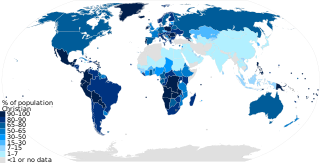
As of the year 2021, Christianity had approximately 2.38 billion adherents and is the largest religion by population respectively. According to a PEW estimation in 2020, Christians made up to 2.38 billion of the worldwide population of about 8 billion people. It represents nearly one-third of the world's population and is the largest religion in the world, with the three largest groups of Christians being the Catholic Church, Protestantism, and the Eastern Orthodox Church. The largest Christian denomination is the Catholic Church, with 1.3 billion baptized members. The second largest Christian branch is either Protestantism, or the Eastern Orthodox Church.
Asia is the largest and most populous continent and the birthplace of many religions including Buddhism, Christianity, Confucianism, Hinduism, Islam, Jainism, Judaism, Shinto, Sikhism, Taoism, and Zoroastrianism. All major religious traditions are practiced in the region and new forms are constantly emerging. Asia is noted for its diversity of culture. Hinduism is the largest religion in Asia with approximately 1.3 billion adherents.

Jaʽfar ibn Yahya Barmaki or Jafar al-Barmaki (767–803), also called Aba-Fadl, was a Persian vizier of the Abbasid caliph Harun al-Rashid, succeeding his father in that position. He was a member of the influential Barmakid family, formerly Buddhist leaders of the Nava Vihara monastery. He was executed in 803 at the orders of Harun al-Rashid.

Yahya ibn Khalid was the most prominent member of the Barmakid family, serving as provincial governor and all-powerful long-time vizier to Caliph Harun al-Rashid before his abrupt fall in 803.
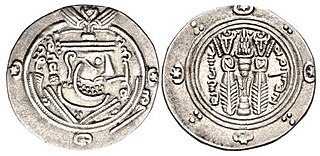
Khalid ibn Barmak was the first prominent member of the Barmakids, an important Buddhist family from Balkh, which converted to Islam and became prominent members of the Abbasid court in the second half of the 8th century. Khalid himself converted to Islam at the Umayyad court in the 720s, but joined the nascent Abbasid revolutionary movement in Khurasan, and played a significant role in the Abbasid Revolution that toppled the Umayyads. He enjoyed close relations with the first Abbasid caliph, al-Saffah, functioning as his chief minister and introducing innovations in record-keeping. Under al-Saffah's successor, al-Mansur, Khalid's influence decreased, but he still occupied significant provincial governorships in Fars, Tabaristan, and Mosul. As an administrator, he distinguished himself for his fairness, especially in matters of taxation, and was a popular governor. He appears to have briefly fallen into disgrace around 775, but he managed to recover, helped by the rapid rise of his son, Yahya. Khalid's ties to the Abbasid dynasty were soon strengthened when his grandson, al-Fadl ibn Yahya, became the foster-brother of the future caliph Harun al-Rashid, while Yahya became the prince's tutor. Khalid died in 781/2, shortly after returning from an expedition against the Byzantine Empire.
The Golden Age of Islam, which saw a flourishing of science, notably mathematics and astronomy, especially during the 9th and 10th centuries, had a notable Indian influence.
Al-Fadl ibn Yahya al-Barmaki was a member of the distinguished Barmakid family, attaining high offices in the Abbasid Caliphate under Harun al-Rashid.
Aban b. 'Abd al-Hamid al-Lahiqi (al-Raqashi) of Basra was a Persian court poet of the Barmakids in Baghdad. He set into Arabic verse popular stories of Indian and Persian origin. He was suspected of Manichaeism.

Adherents of Islam constitute the world's second largest religious group. A projection by the PEW suggests that Muslims numbered approximately 1.9 billion followers in 2020. Studies in the 21st century suggest that, in terms of percentage and worldwide spread, Islam is the fastest-growing major religion in the world, mostly because Muslims have more children than other major religious groups. Most Muslims are either of two denominations: Sunni or Shia. Islam is the majority religion in several subregions: Central Asia, Western Asia, North Africa, West Africa, the Sahel, and the Middle East. The diverse Asia-Pacific region contains the highest number of Muslims in the world, surpassing the combined Middle East and North Africa.
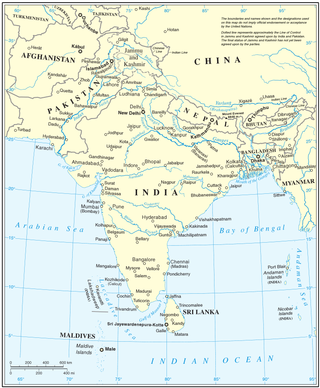
Islam is the second-largest religion in South Asia, with more than 640 million Muslims living there, forming about one-third of the region's population. Islam first spread along the coastal regions of the Indian subcontinent and Sri Lanka, almost as soon as it started in the Arabian Peninsula, as the Arab traders brought it to South Asia. South Asia has the largest population of Muslims in the world, with about one-third of all Muslims living here. Islam is the dominant religion in half of the South Asian countries. It is the second largest religion in India and third largest in Sri Lanka and Nepal.
Maslama ibn Hisham ibn Abd al-Malik, also known by his kunyaAbu Shakir, was an Umayyad prince and commander.
Yaḥyā ibn ʿAbd Allāh ibn al-Ḥasan ibn al-Ḥasan ibn ʿAlī ibn Abī Ṭālib was an Alid and Zaydi leader who led a rebellion against the Abbasid caliph Harun al-Rashid in Daylam in 792. He was soon obliged to capitulate, but his activity began the spread of Zaydi Islam in the remote mountains of Daylam. After his surrender, he was initially treated with much honour, but Harun remained deeply suspicious of his popularity and intentions, and recalled him to Baghdad, where he spent the remainder of his life in prison. In 802, the Barmakid Ja'far ibn Yahya helped him escape, but he was captured; the event led to the execution of the Barmakids, once Harun's closest companions. Yahya died in prison, probably in 803.
Muhammad ibn Khalid ibn Barmak was one of the Barmakids, a family of Iranian functionaries who rose to great power under the Abbasid caliph Harun al-Rashid.
Abu'l-Ḥasan Aḥmad ibn Jaʿfar al-Barmakī al-Nadīm, surnamed Jaḥẓa and al-Ṭunbūrī, was a descendant of the Barmakid family, and a well-known scholar, singer, poet, and courtier of his time.




